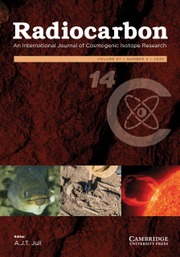No CrossRef data available.
Article contents
Wet deposition of 7Be and 10Be in Xi’an, China: Variation characteristics and influencing factors
Published online by Cambridge University Press: 12 August 2025
Abstract
Cosmogenic 7Be and 10Be are effective tracers for studying atmospheric dynamics and Earth’s surface processes, with over 90% of these isotopes reaching the surface via wet deposition. However, the characteristics and influencing factors of 7Be and 10Be wet deposition remain unclear in different regions, limiting the precision of these nuclides as tracers of environmental change. This study analyzes the annual variation of 7Be and 10Be wet deposition in Xi’an and examines the impact of precipitation on their deposition. Ultra-trace levels of 7Be and 10Be in precipitation were synchronously measured using state-of-the-art accelerator mass spectrometry. One-year (July 30, 2020 to September 3, 2021), high-frequency (individual rain events) and time-synchronized series of observations of 7Be and 10Be wet deposition data (n = 49) were analyzed. The total annual wet deposition fluxes of 7Be and 10Be in central China (34.22°N, 109.01°E) for 2020/21 were (218 ± 24) × 108 atoms·m–2·yr–1 and (314 ± 16) × 108 atoms·m–2·yr–1, respectively. Precipitation amount, intensity, and duration were quantitatively analyzed for their effects on total wet deposition flux, mean concentration, washout ratio, deposition velocity, and scavenging coefficient of 7Be and 10Be during individual rain events. The results indicate that precipitation amount is the most significant factor influencing the wet deposition flux of both nuclides.
Information
- Type
- Conference Paper
- Information
- Copyright
- © The Author(s), 2025. Published by Cambridge University Press on behalf of University of Arizona
Footnotes
Selected Papers from the 4th Radiocarbon in the Environment Conference, Lecce, Italy, 23–27 Sept. 2024


